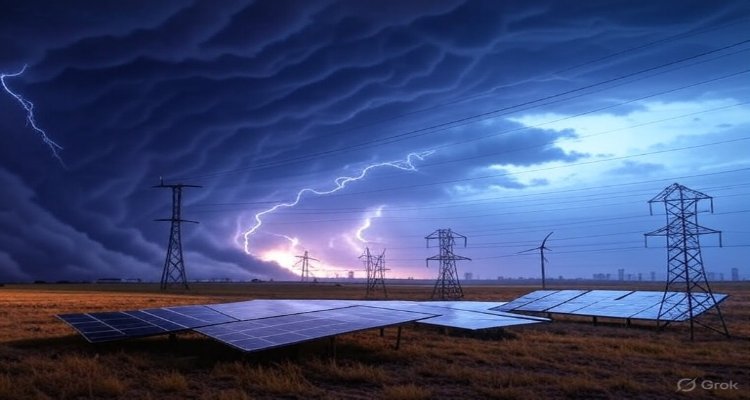The Coming Solar Dust Storm Crisis: Could It Blackout Our Power Grids?
Scientists warn that future solar dust storms could disrupt satellites, GPS, and even cause massive power grid blackouts. How prepared are we?
Introduction
Imagine waking up to a world where your smartphone won’t connect, airplanes are grounded, and cities are plunged into darkness. This isn’t the plot of a science-fiction thriller but a very real concern tied to solar dust storms. With the Sun approaching a peak in its 11-year activity cycle, experts warn of the looming risk of geomagnetic chaos that could overwhelm modern power grids and communication systems worldwide.
Context & Background: A Solar Threat We Can’t Ignore
The Sun constantly ejects streams of charged particles known as solar winds. Occasionally, intense bursts known as coronal mass ejections (CMEs) hurl billions of tons of solar plasma and magnetic fields into space. When these disturbances collide with Earth’s magnetic field, they trigger geomagnetic storms—phenomena spectacular for aurora-watchers but potentially devastating for technology.
One of the most famous instances of this occurred in 1859 during the Carrington Event, when telegraph systems worldwide burst into flames due to a massive solar storm. More recently, in March 1989, a strong solar storm knocked out power to millions in Quebec, Canada, leaving the grid crippled for nine hours.
Now, with our lives even more intertwined with electronics, satellites, and the internet, a severe solar dust storm today could deal unprecedented damage.
Main Developments: Why Experts Are Alarmed Today
Space-weather researchers are observing increasing solar activity as we near Solar Maximum 2025–2026, raising concerns about heightened storm potential. Unlike sporadic flares, solar dust storms refer to intense, prolonged waves of plasma and magnetic turbulence that blanket Earth’s space environment, disrupting systems for days or even weeks.
What makes the current threat alarming is the scale of modern infrastructure dependence:
-
Power Grids: Long transmission lines act as giant antennas, conducting charged currents from geomagnetic disturbances, which can overload and burn transformers.
-
Satellites: Navigation, communication, and weather-monitoring satellites risk orbital drag and failure under storm impacts.
-
Aviation & GPS: Commercial flights crossing polar routes may lose navigation signals and radio communication.
-
Internet Infrastructure: Subsea cables and data centers depend on resilient transformers—weak points in prolonged geomagnetic events.
According to NASA and NOAA, even a 1-in-100 year solar storm could cause trillions in global economic losses, with recovery stretching for months or longer depending on grid damage.
Expert Insight & Public Reactions
Dr. Laura Jensen, a space-weather scientist at the European Space Agency, explains:
“The real danger isn’t just a single blackout. It’s the cascading effect—when the power grid collapses, water systems, hospitals, banking, and communication networks all follow. The impact is systemic.”
Meanwhile, civilian awareness is still low. Most people equate solar storms with the Northern Lights, not realizing the fragile infrastructure at risk. On online forums, tech enthusiasts are increasingly discussing Faraday cages, backup generators, and satellite alternatives as precautionary measures.
Governments, too, are stepping in: the U.S. Department of Homeland Security has classified geomagnetic disturbances as potential national threats, while India and several EU nations have begun hardening grid resilience. Still, funding for large-scale protective infrastructure remains limited.
Impact & Implications: What’s at Stake?
If a large solar dust storm were to strike today, the domino effect could unfold as follows:
Immediate Hours: Satellites fail, GPS accuracy collapses, flight reroutes begin.
Within a Day: Regional blackouts spread, internet slowdowns occur, and global supply chains face communication black holes.
Several Days Later: Entire national grids may require transformer replacements, with critical medical, banking, and energy systems thrown offline.
The economic toll? A 2021 study by the U.S. National Academy of Sciences estimated damages exceeding $2 trillion in the first year of a severe solar event—dwarfing the costs of most natural disasters.
For individuals, the impact extends to daily life: no access to ATMs, disrupted refrigeration, failing water pressure due to electric pumps, and compromised emergency response capabilities.
Conclusion: Preparing for an Inevitable Storm
Whether or not the next great solar storm happens tomorrow or decades from now, experts agree—it’s not a question of if, but when. The Carrington Event has long served as a warning, but with today’s hyperconnected world, the stakes are exponentially higher.
Investments in grid hardening, satellite shielding, and international space-weather monitoring could be the difference between a short disruption and a prolonged global blackout. For individuals, emergency preparedness—like keeping backup power sources, storing essentials, and maintaining offline navigation tools—could prove lifesaving.
Just as humanity prepares for earthquakes or hurricanes, we must now prepare for this cosmic hazard. After all, when the Sun sneezes, Earth has little choice but to brace for the storm.
Disclaimer :This article is for informational purposes only and is not intended as technical or survival advice. Readers should consult official emergency and power infrastructure authorities for preparedness guidelines.











